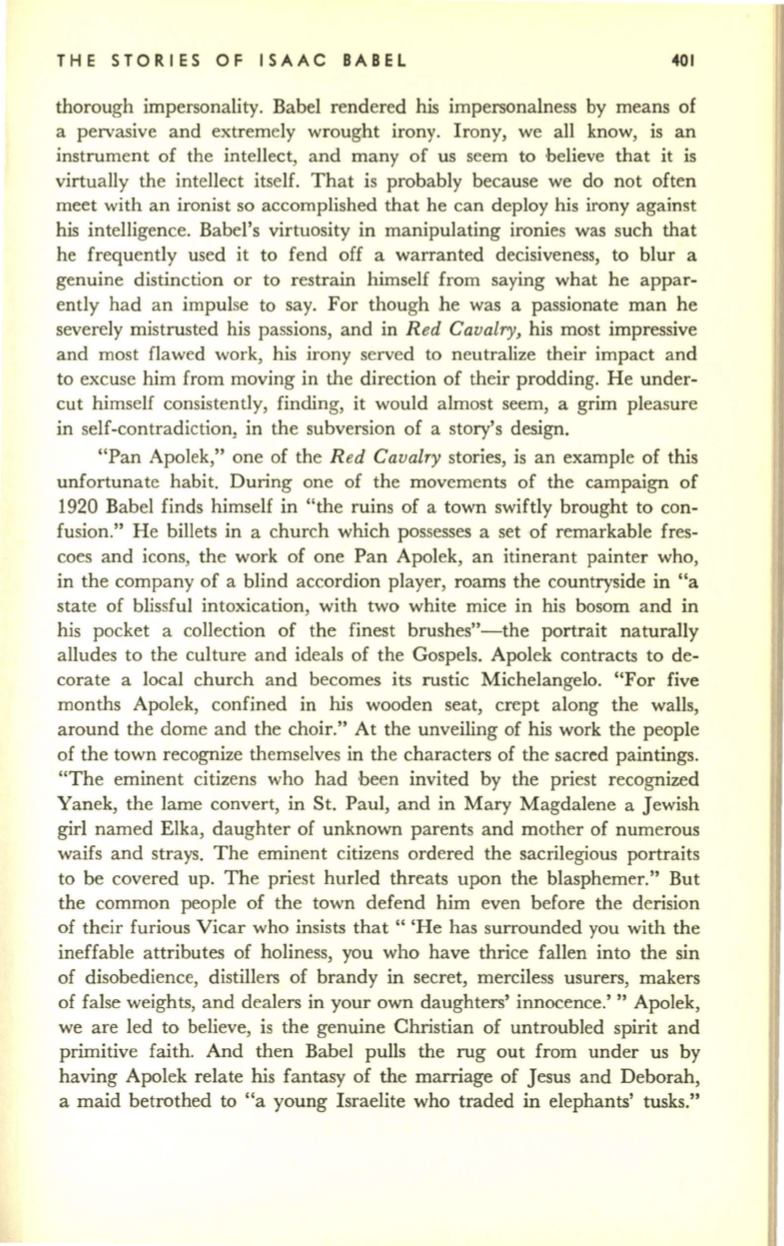
THE STORIES OF ISAAC BABEL
401
thorough impersonality. Babel rendered his impersonalness by means of
a pervasive and extremely wrought irony. Irony, we all know, is an
instrument of the intellect, and many of us seem to believe that it is
virtually the intellect itself. That is probably because we do not often
meet with an ironist so accomplished that he can deploy his irony against
his intelligence. Babel's virtuosity in manipulating ironies was such that
he frequently used it to fend off a warranted decisiveness, to blur a
genuine distinction or to restrain himself from saying what he appar–
ently had an impulse to say. For though he was a passionate man he
severely mistrusted his passions, and in
Red Cavalry,
his most impressive
and most flawed work, his irony served to neutralize their impact and
to excuse him from moving in the direction of their prodding. He under–
cut himself consistently, finding, it would almost seem, a grim pleasure
in self-contradiction, in the subversion of a story's design.
"Pan Apolek," one of the
Red Cavalry
stories, is an example of this
unfortunate habit. During one of the movements of the campaign of
1920 Babel finds himself in "the ruins of a town swiftly brought to con–
fusion." He biIJets in a church which possesses a set of remarkable fres–
coes and icons, the work of one Pan Apolek, an itinerant painter who,
in the company of a blind accordion player, roams the countryside in "a
state of blissful intoxication, with two white mice in his bosom and in
his pocket a collection of the finest brushes"-the portrait naturalIy
alludes to the culture and ideals of the Gospels. Apolek contracts to de–
corate a local church and becomes its rustic Michelangelo. "For five
months Apolek, confined in his wooden seat, crept along the walls,
around the dome and the choir." At the unveiling of his work the people
of the town recognize themselves in the characters of the sacred paintings.
"The eminent citizens who had been invited by the priest recognized
Yanek, the lame convert, in St. Paul, and in Mary Magdalene a Jewish
girl named Elka, daughter of unknown parents and mother of numerous
waifs and strays. The eminent citizens ordered the sacrilegious portraits
to be covered up. The priest hurled threats upon the blasphemer." But
the common people of the town defend him even before the derision
of their furious Vicar who insists that" 'He has surrounded you with the
ineffable attributes of holiness, you who have thrice fallen into the sin
of disobedience, distiIJers of brandy in secret, merciless usurers, makers
of false weights, and dealers in your own daughters' innocence.' " Apolek,
we are led to believe, is the genuine Christian of untroubled spirit and
primitive faith. And then Babel pulls the rug out from under us by
having Apolek relate his fantasy of the marriage of Jesus and Deborah,
a maid betrothed to "a young Israelite who traded in elephants' tusks."


